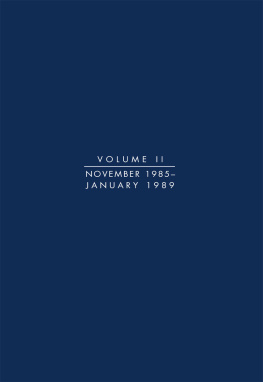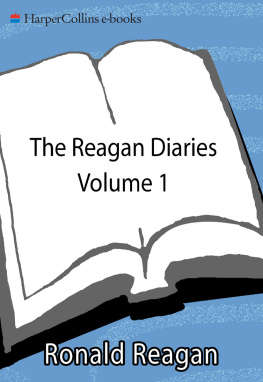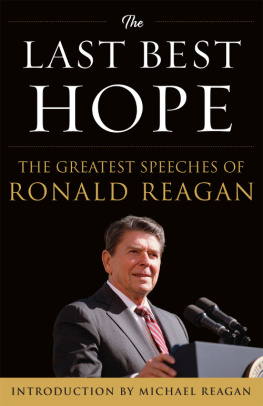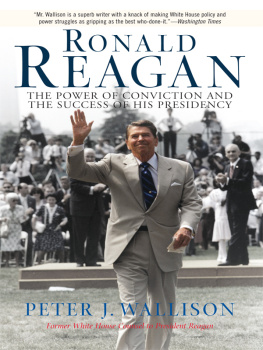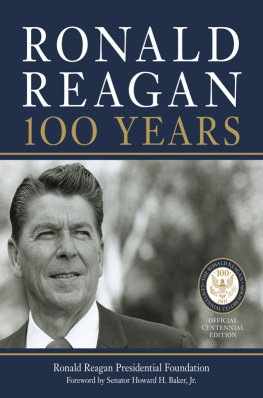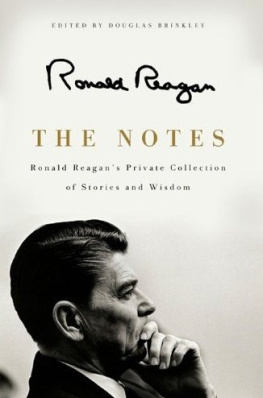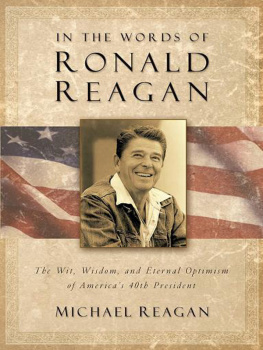Contents
To my children, Sarah Sophia, and Henry IV
I grew up as a conservative Republican in Ronald Reagans California. To call me die hard would be understating my belief and commitment: I was the only volunteer in the Santa Clara County GOP HQ on August 9, 1974, the day Richard Nixon resigned. Working my way up from a volunteer to a young political consultant to a candidate myself, I inhaled the standard California conservative belief in very low taxes, a minimum of government, and a maximum of personal freedom. And like all Californians of that age, I knew who our leader was: Ronald Wilson Reagan.
Leaving the Golden State in my midtwenties didnt make me any less of a California conservative. I was part of the conservative Federalist Society while at law school and clerked for a former Reagan staffer on the US circuit court. The candidate I helped elect to the Pennsylvania state House in 1994 was derided as an extreme right-winger. My postlaw career took me into the free-market think tank world, where for twenty years I held high executive posts in nationally known institutions. Ronald Reagan and limited government were as important to me in my forties as they were in my teens.
Barack Obamas election and the Republican wipeouts of 2006 and 2008 were catastrophic events that shook me to the core. They should not have happened according to everything the conservative movement had been saying for decades. Republicans were increasingly becoming conservative, and increasingly winning more elections at all levels. Polls showed America remained a center-right nation where conservatives outnumbered liberals by about two to one. Yet this country had decisively elected the most liberal man ever to be nominated by a major party for president. How could this happen?
As dark as things looked in early 2009, I remembered they looked even darker in 1977 when Republicans held less than a third of the seats in the House of Representativesand fewer than half of those Republicans were conservatives. Four years later, led by Reagan, conservatives had taken over the GOP and dethroned liberal Democrats from the political perch they had held for a generation. I resolved to look back to learn what Reagan did so that I could help todays conservatives meet our rendezvous with destiny.
What I found shocked me. Everything I had been told about Reagans philosophy, by the Right and the Left, had been wrong. And I learned it was his own distinct and original philosophy, not his charisma or his pragmatism, that had allowed him to change his party, his country, and his world.
This book is the story of what I found. It is the story of a young New Dealer who moved to California and became a conservative, but never left his youthful admiration of Franklin Roosevelt behind. It is the story of a man whose conservative conversion did not lead him to abandon his belief that governmentpreferably state or local, but federal if necessaryshould give people in need a hand up to help them pursue their dreams.
It is the story of a man who, while lionized by the Right and demonized by the Left, transcended left and right.
It is the story of the real Ronald Wilson Reaganand how conservatives today could realize their dreams if only they knew who he was.
This story will revise what most people think about Reagan. It will lay to rest the claims that he sought to tear down the modern entitlement-welfare state in favor of a nineteenth-century night watchman state that protects peoples bodies while being indifferent to their souls. It will show that from the minute Reagan entered the political arena he rejected the idea shared by left and right that the major political question was purely over government power. It will show that while Reagan was suspicious of government power, he always believed that justice and fairness were more important measures of what government did than the simple fact that it did it.
In short, it will show that Reagan was a working-class Republicanand that this unique philosophy was the secret to his political success.
We will start our journey at the beginning, those youthful years when Reagan was what his older self called a hemophiliac liberal. His devotion to Franklin Delano Roosevelt knew no bounds; Reagans contemporaries remember him as hopelessly committed to the president who remade America and the Democratic Party. Our study will show, however, that his liberalism was not theoretical or ideological. Instead, it came from a deep love for the average individual and Reagans belief that every person was capable of leading a free and dignified life. His support for the New Deal, then, was based on the thought that Democratic policies were intended to enable people to live that free and dignified lifeand that those policies worked.
Reagans belief came from many sources, but none of them were more important than the lessons he learned from his family and his early life experiences. We will learn that Reagans father was an Irish Catholic Democrat who preached tolerance, respect for hard work and country, and a belief in the nobility of the working person. His mother was neither Irish nor Catholic, but she shared her husbands core political principles as well as his faith in the Democratic Party. Neither parent graduated from high school, much less attended college. Together with a hardscrabble upbringingReagan often said later in life that we were poor, we just didnt know itthat included brushes with poverty, unemployment, and government relief, Reagan entered adulthood with a strong knowledge of what average, working Americans thought, felt, and faced in their daily lives.
These Americans also shared Reagans love of Roosevelt and faith in the New Deal. A large majority of the Americans who worked in factories, mines, and industry were European immigrants. While a large majority of the Irish had been Democrats since before the Civil War, most other immigrants had been progressive Republicans. They had backed the party that promised them prosperitya full dinner pailthrough high tariffs that favored industry. But within the GOP, these voters tended to prefer crusaders like Theodore Roosevelt, men who promised to break up big business cartels known as trusts, pass workplace safety and injury compensation laws, and generally back the average person when the big business owner seemed to get in the way of peoples ability to lead dignified and free lives. When the economy collapsed in 1929 and continued to sink throughout the presidency of Republican Herbert Hoover, these voters abandoned the GOP in droves and joined forces with the FDR-led Democrats. They would stay loyal to that party until, like Reagan, they came to believe that the Democratic Party had left them in the 1960s and 1970s.
These voters did not want socialism or significant changes to the American way of life. They wanted what the Republicans had promised and delivered for decadesa hand up that gave everyone a chance at dignity, comfort, and respect. Historians and professors argue even today about whether FDR and his staff really wanted to do this or if they secretly wanted to remake America into a less individualistic and more socialistic country. There were certainly those among Roosevelts coterie who did want to take the latter courseand they carried on their crusade within the Democratic Party for decades after his death. But what Roosevelt told the American people and what he sold them on was exactly what they wanted.
Understanding what I call the public New Deal is essential to understanding Reagans thought, his political journey, and the reason why he was politically successful. Roosevelt and his early heirs did not preach reliance on government or the virtues of an expert elite. Instead, they emphasized the virtue and dignity of the average American. They argued that these forgotten men could prosper with a government big enough to help them remove the obstacles in their path. To vote for Roosevelt in the 1930s and 1940s was not to vote to remake America, they argued, but to renew its eternal promise for all.




